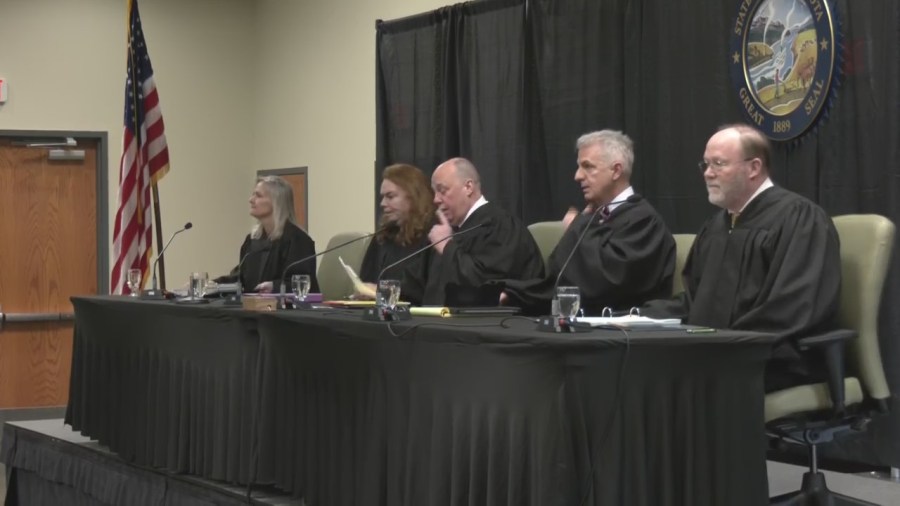SIOUX FALLS, S.D. (KELO) — A lawyer for the state said the state doesn’t need to follow county zoning rules for a proposed men’s prison while lawyers for the plaintiffs said the state should in arguments made Tuesday before the South Dakota State Supreme Court.
Arguments for the plaintiffs started first followed by the defendants’ lawyer.
Federal judge will not overturn Piper death penalty
Neighbors Opposing Prison Expansion (NOPE) is appealing Lincoln County 2nd Circuit Court Judge Jennifer D. Mammenga’s dismissal of its case against the state of South Dakota.
The lawsuit claimed the state should have followed Lincoln County zoning ordinances when it chose the site for the planned new men’s prison between Harrisburg and Canton.
Mammenga wrote in her October opinion that the state (defendants) are immune from the lawsuit under the doctrine of sovereign immunity.
Tuesday the heart of the disagreement between the state and the plaintiffs were shared in court.
Arvid Swanson, a lawyer for the plaintiffs, said in his arguments that the Supreme Court must consider the need to balance the interests of those affected by a possible new men’s prison. The state should be required to follow the zoning ordinances of Lincoln County.
“The state is immune from the suit based on its sovereign immunity,” the defendants’ lawyer Grant Flynn said.
During his arguments, Swanson cited 1970s case involving Lincoln County that he said shows the balance of interest should be considered for the prison site.
Flynn argued that the case does not indicate balance of interest. The case involved the city of Sioux Falls seeking to build a landfill outside of the city’s jurisdiction, Flynn said.
With Sioux Falls, the city was venturing outside of its domain or jurisdiction, Flynn said.
No portion of South Dakota that exists outside a county, Flynn said. No county zoning should apply to the state, he said.
Swanson cited his review of several state laws that do not disclose exemptions from zoning. Zoning ordinance and laws are pretty clear, there are no exemptions, Swanson said.
Swanson said the state prison selection process was in secret and when the site was announced, the process had turned the county board into a neutral party. It was up to the plaintiffs to take action, Swanson said.
Did the county have a duty to take action?, Salter asked Swanson during his arguments.
Swanson said the county should take action if there is a violation of a county zoning ordinance.
“I think we were basically cut loose (and left to do it on our own),” Swanson said.
Neighbors have a right to challenge a position if the county does not, Swanson said.
Judge Steven Swenson asked what is the basis for a county to apply zoning to a sovereign state?
Judge Janice Kern asked about recently passed laws and any possible impact on the case.
Swanson said the state’s opinion on its abilities are cause for review not that the prison site is being re-evaluated.
During arguments, Judge Mark Salter said the lawsuit was not asking for relief to stop the construction of the prison directly. “It’s a due process claim,” Salter said. It’s asking for the state to work under county zoning ordinances, he said. It’s asking for an opportunity to be heard, he said.
In response to Salter, Flynn said he doesn’t disagree with what the lawsuit is seeking. Flynn said the plaintiff’s desire to be heard is not justified in case law or prior court rulings.
Later, near the close of his arguments, Flynn said the case was about the plaintiffs not wanting the prison in their area and this was an attempt to stop it from being built.
Zoning ordinances do not apply, Flynn said. The state is not required to follow the county zoning, he said.
Flynn was asked by a judge if the county had a ministerial duty to enforce county zoning.
Flynn said that is not an issue that applies to this lawsuit.
Declaratory relief is heavily involved in this case, Judge Patricia DeVaney said.
Flynn said the state’s position is that the appellants have not applied appropriately for declaratory judgment because they do not qualify.
It is a plea for due process, Swanson said of the plaintiff’s lawsuit., after Flynn’s arguments. The prison would drastically change the use and operation of the land, he said. “Can’t believe the state can so easily trample (interests),” Swanson said.
NOPE opposes a proposed prison site between Harrisburg and Canton and filed a lawsuit against the South Dakota Department of Corrections, the state of South Dakota and DOC Secretary Kellie Wasko. The lawsuit claimed the state should have followed Lincoln County zoning ordinances when it chose the site for the planned new men’s prison between Harrisburg and Canton.
Mammenga wrote in her October opinion that the state (defendants) are immune from the lawsuit under the doctrine of sovereign immunity.
The heart of the plaintiffs’ argument is that the state should be required to follow zoning laws on the site of a proposed men’s prison.
“Defendants’ selection of the proposed prison site is not subject to Lincoln County’s zoning laws and comprehensive plan,” when the general rule or the balances of interest test is reviewed and applied, Mammenga said in her ruling.
What to know about South Dakota’s Supreme Court
The five members of South Dakota’s Supreme Court are appointed by the governor from judicial districts and the picks are subject to statewide electoral approval three years after appointment and every eight years after that.
South Dakota Supreme Court Justices must retire at age 70 and the Supreme Court is final judicial authority on all matters involving the legal and judicial system in South Dakota.
The members of the South Dakota’s Supreme Court are Chief Justice Steven Jensen, Janine Kern, Mark Salter, Patricia DeVaney and Scott Myren.
Kern was appointed by Gov. Dennis Daugaard in 2014, Jensen was appointed by Daugaard in 2017 and Salter was appointed by Daugaard in 2018. Gov. Kristi Noem appointed DeVaney in 2019 and Myren was appointed by Noem in 2021.
The court travels throughout the state to hear oral arguments to give citizens in the state a better opportunity to see and hear how the court functions. The South Dakota Supreme Court allowed both television and still cameras in the Supreme Court in August 2001.
The South Dakota Supreme Court issues opinions on cases every Wednesday, which are made public on Thursdays.




